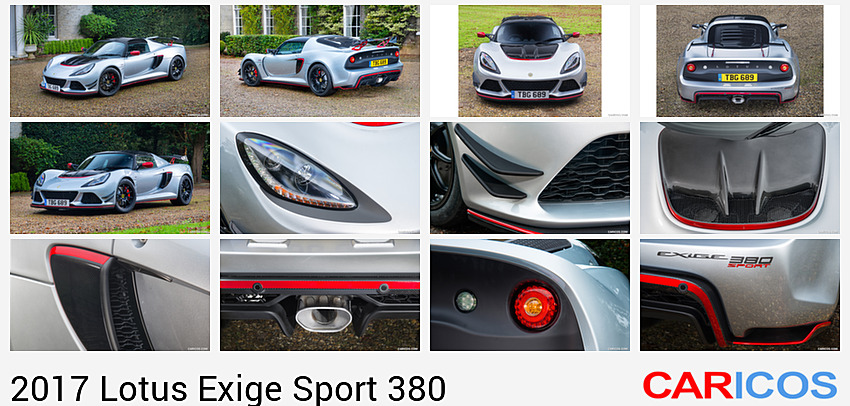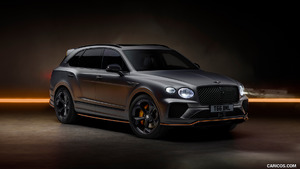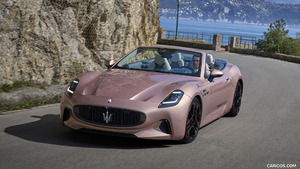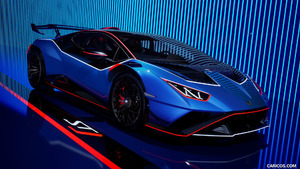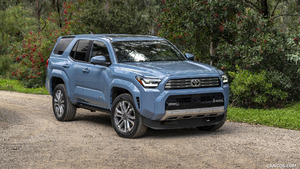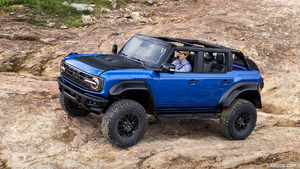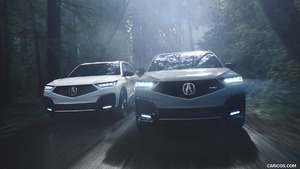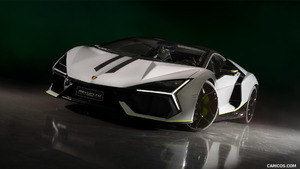Lotus Exige Sport 380
High powered, highly evolved, and ferociously fast, the Lotus Exige Sport 380 is the most aggressive iteration yet for the Exige model line up.
Taking the fight straight to six-figure supercars, this new, top-of-the-range model carries over the lessons learnt in the development of the acclaimed Exige Sport 350, launched last year, but with significant revisions lowering weight, boosting power and enhancing aerodynamics.
Rather than relying excessively on electronics, or allow sterile interfaces to dull the experience, the extreme Exige Sport 380 offers a pure, undiluted drive that has to be experienced to be fully appreciated.
Unrivalled in its class: faster, sharper, and more direct than adversaries, the Exige Sport 380 is definitely not for the timid. With a dry weight of just 1,066 kg with lightweight options, and boasting a potent power-to-weight ratio of 352 hp per tonne, the new, pure-bred Lotus has been conceived to out perform and out manoeuvre so called supercars. The new Exige is blisteringly fast off the line, dispatching 0-60mph in 3.5 seconds before reaching a top speed of 178 mph.
From the intricately engineered exposed-gear-change linkage, to the swathes of carbon-fibre components and Michelin Pilot Sport Cup 2 tyres as standard, every inch of the Exige has been carefully cultivated. Firmly defined as a Lotus for the enthusiast, the car can be seen as an expression of intense engineering - challenging accomplished drivers to extract the car’s true potential.
Jean-Marc Gales, CEO of Group Lotus plc, commented: “We’ve saved something special for our last new car of 2016. We have built upon the foundations of the excellent Exige Sport 350 and developed a perfectly proportioned, intuitive and attainable supercar for real roads. The cut in weight is nothing short of drastic and, combined with the hike in power and its enhanced agility, we’ve created something exceptional - far greater than the sum of its parts. The Exige Sport 380 is so good, that it is no longer the best in class, it’s now in a class of its own.”
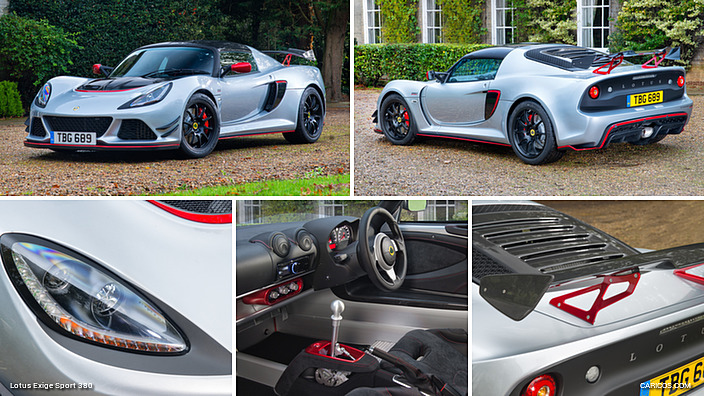 2017 Lotus Exige Sport 380
2017 Lotus Exige Sport 380
Unashamedly analogue and unfiltered
Lotus’ approach to developing the perfect sports car has allowed the Exige Sport 380 to lay claim to the title of the best sports car under £100,000. A true supercar car for the road, the Exige focuses on the three key attributes that have made the company a firm favourite with driving enthusiasts: reduced weight, higher performance and honed aerodynamics.
Raised on the roads around Hethel, and exercised on the company’s famous test track, the new car can trace its lineage back to the very first Exige, launched in 2000. Now the headline car of the range, sitting above the Sport 350 model, it is instilled with Lotus’ DNA and packed with a potent 375 hp engine into Lotus’ acclaimed two-seater.
Weight less
While employing some of the high-performance components premiered on the Exige Sport 350, Lotus returned to the Lightweight Laboratory in order to cut kilos from the kerb weight. Infused with carbon fibre from front to back, the Exige Sport 380 features hand-made, high-gloss visible weave components as standard to deliver a weight saving when compared to the Exige Sport 350. This includes the front splitter, revised front access panel, new rear wing and rear diffuser surround, which together save 2.7 kg. A lightweight, transparent polycarbonate rear window saves 0.9 kg over the glass equivalent in the Exige Sport 350. In addition, the carbon race seats (-6 kg), lithium-ion battery (-10.3 kg), ultra-lightweight forged wheels and grooved two-piece brake discs (-10 kg) combine to cut a massive 26.3 kg. A new design of rear transom panel now has two rear light clusters, rather than the four on the Exige Sport 350, with reversing and fog lights now mounted inboard, cutting weight by a further 0.3 kg.
In line with its illustrious lineage, the Exige Sport 380 employs Lotus’ lightweight extruded and bonded aluminium structure, as the company continues to lead in the field of advanced automotive construction techniques. Lotus is working continuously to engineer out the excess mass from its cars, and the company’s chassis technology remains the benchmark.
Power play
The company’s powertrain division has left its mark on the car, with the uprated 3.5-litre supercharged V6 engine generating 375 hp at 6,700 rpm and 410 Nm (302 lbft) of torque at 5,000 rpm. Refined from extensive testing and development, it’s a design that’s proved its mettle by powering some of Lotus’ latest supercars, including the track-focused 3-Eleven and the recently revealed Evora Sport 410.
The power boost comes from a revised supercharger pulley, which increases charge pressure, an uprated fuel pump, a recalibrated ECU and the introduction of a revised exhaust system – as used in the Evora 400 and Evora Sport 410. Allowing owners to enjoy the new Exige for longer between fuel stops, it also comes with an enlarged, 48-litre petrol tank.
Providing faster, cleaner changes, the Exige Sport 380’s six-speed manual gearbox uses Lotus’ acclaimed open-gate design. Eliminating lateral movement, by precisely aligning components, it features light-weight machined and cast aluminium parts. Aesthetically appealing, the open transmission mechanism also helps contribute to the car’s reduced weight. The manual gearbox has been further enhanced through the introduction of a new oil cooler, ensuring the gears operate at the optimal temperature no matter how hard they are performing.
The Lotus Exige Sport 380 is also available with an optional six-speed automatic gearbox, where drivers can select gears sequentially via the forged aluminium paddles located behind the steering wheel, or rely on the gearbox’s fully automatic mode. The automatic gearbox option will be available from Spring 2017.
The Lotus Exige Sport 380 features Lotus’ Dynamic Performance Management (DPM) which provides enhanced ‘Sport’ and ‘Race’ settings. Proportionally increasing throttle response, lowering traction slip thresholds and removing understeer recognition, it provides the driver with a finer level of control before the system intervenes. DPM also utilises an engine exhaust bypass valve at midto- high engine speeds, further reducing back pressure to boost throttle response and engine performance in both ‘Sport’ and ‘Race’ settings.
Aero advantage
As with all Lotus cars, aerodynamic efficiency plays a key role in the Exige, helping it to drastically expand its performance envelope. Extensive CFD modelling work has allowed Lotus’ design team to fine tune specific areas, in order to deliver a substantial overall improvement. The revised front access panel modifies the air flow exiting the car’s horizontally mounted radiators, before it travels over the car, while the carbon front spoiler and rubber lip spoiler combined with the carbon barge boards reduce pressure under the vehicle.
In addition, twin pairs of front canard wings, mounted forward of the front wheels, a carbon rear wing and air blades behind the rear wheels, all work to help raise downforce to a massive 140 kg at maximum speed - a 60% gain over the Exige Sport 350, which generates 88 kg at its maximum speed. This increase in downforce does not come at the penalty of drag which remains the same as the Exige Sport 350.
Favouring mechanical solutions over electronic systems, including key parts such as unassisted steering, means that the Exige Sport 380 delivers the driver an intuitive experience. The extensive use of carbon fibre on the bodywork has lowered the centre of gravity, helping contribute to the Exige’s exemplary steering feel and precision handling characteristics.
Making the most of its performance potential, the Exige Sport 380 is fitted with Michelin Pilot Sport Cup 2 tyres as standard (265/35 ZR18 rear and 215/45 ZR17 front). Selected for their tenacity, and 10 mm wider at the front than on the Exige Sport 350, the increased mechanical grip is complemented by the car’s ultra-lightweight forged alloy wheels, which are available in either black or silver. Either option is complemented by AP Racing forged, four-piston brake callipers and grooved performance two-piece brake discs.
In addition to its already impressive credentials, it’s possible to sharpen the Exige further still. Opting for the full exhaust system in titanium improves the car’s overall balance, by removing 10 kg from beyond the rear axle. For customers who frequently go to the track, the optional Track Pack provides Nitron two-way adjustable dampers and Eibach adjustable front and rear anti-roll bars.
The optional Carbon Exterior Pack contains a one-piece carbon roof panel and a distinctive carbon louvered tailgate. The carbon roof panel is 2 kg heavier than the standard soft-top but this weight increase is offset by the carbon louvered tailgate which saves 2 kg.
As befitting such a stand-out car, the Exige Sport 380 is sprayed and hand finished in one of ten individual colours. Providing some drama and drawing the eye to the beautiful composite carbon components, an optional exterior accent pack is also available in one of five key colours to deliver some finer detailing to the car’s undeniable presence.
The car’s kerb appeal is enhanced by revisions to the Exige’s design front and back. Distinctive blackened headlamp surrounds provide a more aggressive demeanour, whilst to visually accentuate the width of the rear of the car, a new rear transom features two lamp clusters rather than four.
The hand finished detailing continues inside, with the carbon fibre sports seats trimmed with either Alcantara®, leather or tartan, with all featuring contrast stitching.
The optional lightweight carbon fibre sill covers provide a motorsport theme when entering or exiting the Exige Sport 380 and, thanks to their lower profile and contoured finish, aid ingress and egress. The Interior Colour Pack provides contrasting surrounds to the transmission console, HVAC surround, carbon seat eyelets and electric window bezels in one of four colours. A new integrated entertainment system can also be specified, including iPod® connectivity and Bluetooth® functionality, along with air conditioning.
For owners wanting more, the new Exige Sport 380 can be personalised through the increasingly popular Lotus Exclusive programme. Combining traditional British craftsmanship with modern design, the service inspires customers to spend time tailoring the character of their Lotus with a comprehensive array of options.
The Lotus Exige Sport 380 is available as a roadster as standard and as a coupe as an option.
Manufacturer’s Suggested Retail Price
| UK (Pound Sterling) | £67,900 |
| Germany (Euros) | €89,900 |
| Japan (¥ Yen) | ¥12,760,000 |
Technical Specification:
| PERFORMANCE | Manual | Automatic |
| Max power | 375 hp (380 PS, 280 kW) at 6,700 rpm | |
| Max torque | 410 Nm (302 lbft) at 5,000 rpm | |
| 0-60 mph | 3.5 seconds | 3.5 seconds |
| 0-100 km/h | 3.7 seconds | 3.7 seconds |
| Max Speed | 178 mph (286 km/h) | 170 mph (274 km/h) |
| Kerb Weight (with lightweight options) | 1,110 kg (1,100 kg) | 1,121 kg (1,111 kg) |
| Dry Weight (with lightweight options) | 1076 kg (1,066 kg) | 1,087 kg (1,077 kg) |
| Downforce at maximum speed | 140 kg | 140 kg |
| Fuel Consumption mpg (l/100 km) * | ||
| Urban / Extra Urban /Combined | 19.5 (14.1) / 37.2 (8.3) / 28.0 (10.4) | 21.1 (13.3) / 39.8 (7.6) / 30.1 (9.7) |
| CO2 emissions | 242 g/km | 225 g/km |
* Final fuel consumption and emissions figures to be confirmed

